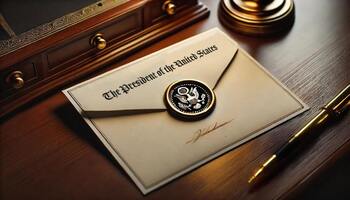
Dear Mr. President,
Recently you have expressed an intention to do an audit of the gold at Fort Knox and presumably also the other vaults where the U.S. monetary gold is stored.
If you proceed with this endeavor, you will be misleadingly told by the U.S. Treasury, the owner of the gold, that the metal is annually audited by the Office of Inspector General (OIG) together with an independent public accountant, KPMG LLP.
The 2024 audit report of the “United States Mint’s Schedules of Custodial Deep Storage Gold and Silver Reserves” stored at the U.S. Mint, including the depositories at Fort Knox, West Point, and Denver, can be found on the OIG website here. The report on the gold stored at the Federal Reserve Bank of New York (FRBNY) is here. No need for any new audits, the bureaucrats will say.
But don’t be fooled. While it's true that currently the OIG inspects the permanent tamper-evident seals covering vault compartments annually, and KPMG has accompanied the OIG during these expeditions, these audits are anything but credible if you would know what happened to those compartments before the last seals were put on.
I have been researching the U.S. gold reserves audits for many years, all the way back to 1974, and submitted countless FOIA requests at the Treasury (owner), Mint (custodian), FRBNY (custodian), and OIG (auditor) that unearthed previously undisclosed documents. In total, I have published nine articles about my findings1.
The full list of anomalies and problems regarding the audits would be too lengthy to discuss here, but below are a few unsettling conclusions:
- Repeatedly auditing staff deviated from the prescribed auditing protocol, while the internal controls designed to prevent such deviations were failing.
- Numerous audit and assay reports have been lost or destroyed.
- For decades, a significant portion of the metal was excluded from verifications without any apparent reason.
- The U.S. government went to great lengths to withhold information about the audits.
- The permanent tamper-evident seals, placed on vault compartments after they were audited, meant never to be broken again, have repeatedly been broken. The OIG has carefully avoided this subject when it testified under oath, and on another occasion lied about it.
Given the significance of this subject, I would like to expand on the most sensitive issue at hand: the frequent re-opening of vault compartments placed under Official Joint Seal. As such breaches mean there can be no assurance the vault compartments still contain the gold they should.
An Introduction
You will know that (on paper) the U.S. holds the largest official gold reserves in the world, accounting for 8,134 metric tonnes. While this gold no longer backs the U.S. dollar at a fixed parity as it did before 1971, it serves as essential support and a final backstop to the dollar, contributing credibility to the dollar’s status as the world reserve currency.
The majority of the gold is stored at a U.S. Mint depository at Fort Knox, while smaller quantities are kept at Mint depositories in Denver and West Point. Collectively, this volume is known as Deep Storage gold and is secured within 42 sealed compartments. The remainder is stored at the FRBNY.

Source: U.S. Treasury. Next to the Deep Storage of gold at the Mint and metal at the FRBNY, there are 87 tonnes stored at the Mint that can be utilized as working stock for producing coins.
The current audits commenced in 1974 and were designed to annually verify 10% of the gold, place verified compartments under “Official Joint Seal,” and after all compartments were attested in 1983 inspect the seals every year (page 36, page 534). But unfortunately, this is not what unfolded.
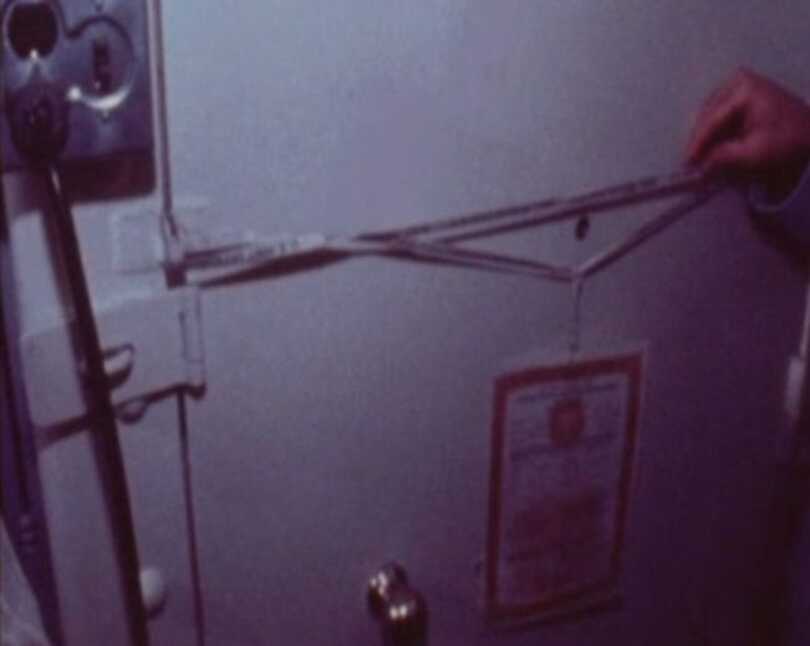
Sealed vault compartment at Fort Knox.
How the Audit Procedures Have Failed
Representing the OIG, Eric M. Thorson attended the congressional hearing for the Gold Transparency Act of 2011 that was initiated by Ron Paul (not enacted). Mr. Thorson’s testimony at the hearing serves as the official statement by the auditor. Having weighed his words carefully, Thorson stated:
… 100 percent of the U.S. Government’s gold reserves in the custody of the Mint has been inventoried and audited.
… the Committee for Continuing Audit of the U.S. Government-owned Gold [The Committee that started the audits] performed annual audits of Treasury’s gold reserves from 1974 to 1986.
… by 1986, 97 percent of the Government-owned gold held by the Mint had been audited and placed under joint seal. So once you have done that, and that seal remains unbroken, then I am not sure what other benefit there would be to going back into it at that point.
Since 1993, when we [OIG] assumed responsibility for the audit, my office has continued to directly observe the inventory and test the gold. In fact, my auditors signed the official joint seals … placed on those compartments.
At the end of Fiscal Year of 2008, all 42 compartments had been audited by … the Committee for Continuing Audit of the U.S. Government-owned Gold, or my office, and placed under official joint seals.
In summary:
- From 1974 until 1986, 97 percent of the Deep Storage gold had been verified by the so-called Committee for Continuing Audit.
- In 1993 the OIG became responsible for the audits, and by 2008 all compartments had been verified and sealed.
Two assumptions we can derive from Thorson’s testimony:
- From 1987 until 1992, there were no audits.
- From 1993 until 2008, the remaining 3 percent of the gold was verified.
Thorson didn’t mention anything about vault compartments having ever been re-opened.
To refute Thorson’s testimony, it’s paramount to first establish the OIG did not assume responsibility for the audits since 1993, but as early as 1982. From one of the few documents that survived the 1980s (page 2):
Effective October 1, 1982, the Internal Audit Staffs of BGFO and the United States Mint [Committee for Continuing Audit] were reorganized under the Department of the Treasury, Office of the Inspector General [OIG].
On the front page of an audit report from 1985, we can clearly see the OIG’s name:
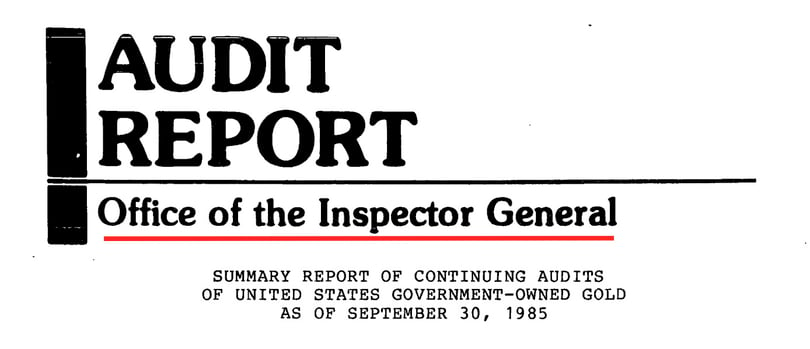
Second, ever since the OIG became part of the audits in 1982, exactly what was not supposed to happen, did happen: vault compartments that had been physically verified and sealed were re-opened.
Read with me, from the 1986 audit report with respect to Fort Knox (Pages 7 and 8):
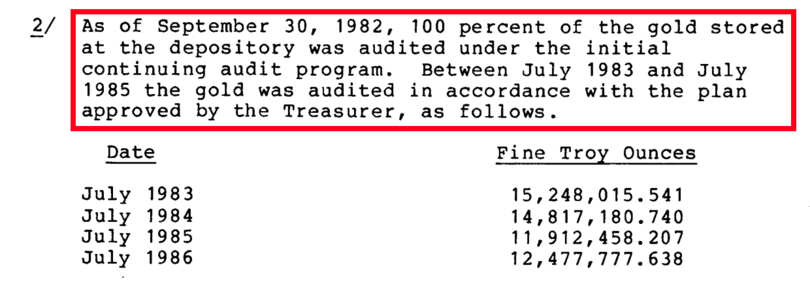
For dubious reasons, from 1983 until 1986 ‘re-audits’ of 1,929 tonnes were performed at Fort Knox and Denver (sealed compartments were re-opened while both depositories were fully audited by then) “in accordance with the plan approved by the Treasurer.” Meanwhile, Deep Storage compartments at West Point had never been audited.
Why didn’t the OIG finish the audits at West Point, as intended, but instead began breaking permanent seals at Fort Knox and Denver? Thorson himself said in 2011 that “once you have done that [placing seals] and that seal remains unbroken, then I am not sure what other benefit there would be to going back into it.”
One more time, to be sure, the purpose of the seals, as we can also read from the Mint’s annual report 1974/1975 (page 36), was that when compartments had been verified and sealed, “these actions having once been performed … will not have to be repeated as long as the assets verified remain under an unimpaired joint seal.”
More Lies by The Auditor
What Thorson meticulously avoided discussing under oath, he included in a written statement for the Gold Transparency Act of 2011 (page 45):
From 1986 to 1992, the Mint continued to perform an annual inventory and verification of the gold reserves in accordance with its own policies over those compartments that had not been placed under Official Joint Seal…
So, the U.S. Mint audited its custodial gold “in accordance with its own policies” from 1987 through 1992, though the OIG was already in charge at the time. This is like a bank opening its customers’ safety deposit boxes while the auditor decided to take a sabbatical.
Also, note that Thorson states that the Mint exclusively opened “those compartments that had not been placed under Official Joint Seal.” This is a lie and I can prove it to you.
Through FOIAs, I obtained copies of seals that were placed by the Mint on 5 Deep Storage compartments between 1987 and 1992. Thorson is wrong because all these seals were placed at Fort Knox and Denver, which were verified and sealed by late 1982.
Please have a look at one of the seal copies:
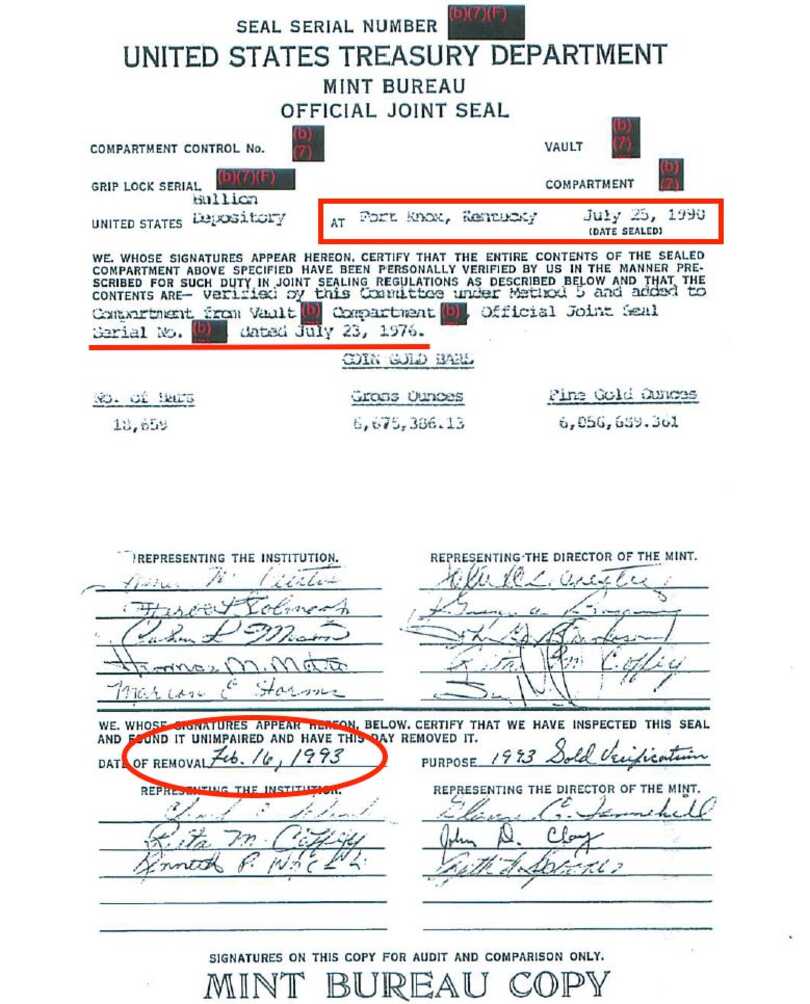
At the top you can see the “date sealed”, “July 25, 1990,” and the depository is “Fort Knox, Kentucky,” which was fully audited by 1982 (and some compartments re-audited from 1983 through 1986).
You can also see on the seal when this compartment was “sealed previously.” It was in 1976 (underlined in red), confirming it was a re-audit. There is no possibility that this compartment was audited for the first time in 1990, as suggested by Thorson.
Last but not least, at the very bottom, you can see a date, “February 16, 1993,” which is when this seal was removed by the OIG (presumably for yet another ‘re-audit’). More evidence that the OIG must have known what happened to these compartments between 1987 and 1992. Removing the seal in 1993 by the OIG (after their sabbatical) clearly would have told the history of this compartment.
You will also notice the OIG left a trail so complicated, whereas the audit setup in 1974 seemed so simple. Why?
Conclusion
Physical gold audits are supposed to remove any doubt about the presence of gold at a specific custodian. But when we look beneath the surface of the audits discussed above, we have to conclude they actually raise more doubt than reassurance about the safety of the U.S. official gold reserves.
Sadly, Mr. President, the above-noted problems are just the tip of the iceberg. Why were the physical inventories not completed in 1983? Why did the OIG re-open compartments between 1983 and 1986? Why again between 1987 and 1992? Why was the gold at the FRBNY never audited in 2011? The list is endless and it would take a book to adequately discuss all problems related to the audits.
A new, credible audit could verify that all U.S. Treasury gold is physically accounted for. But the process should not stop there. Another question to be examined and reported about is whether any encumbrances have been placed upon the gold, via swaps, leases, pledges, or any other form of rehypothecation.
Hopefully, this letter contains useful information for you, and your administration will conceive of and execute a new full audit of all the U.S. monetary gold. Then we can all finally put this topic to rest. A template for this was created by Congressman Alex Mooney’s Gold Reserves Transparency Act last introduced in 2021 with the help of the Sound Money Defense League.
For more information please refer to my prior articles that can be found in the notes1.
Notes
- In my last article on this subject, “U.S. Official Gold Reserves Auditor Caught Lying,” the links to all my articles spread over several websites are disclosed. For anyone who wants to get a full picture of all issues with the audits make sure to read my last and second to last article: “Audits of U.S. Monetary Gold Severely Lack Credibility.”
- The original documents state “1975” but for the sake of simplicity I have changed it to “1974”. Officially, the Committee for Continuing Audit of the U.S. Government-owned Gold started in 1975, but because they accepted the audit performed in 1974 in their program effectively their program started in 1974.
Originally Published on Money Metals.



